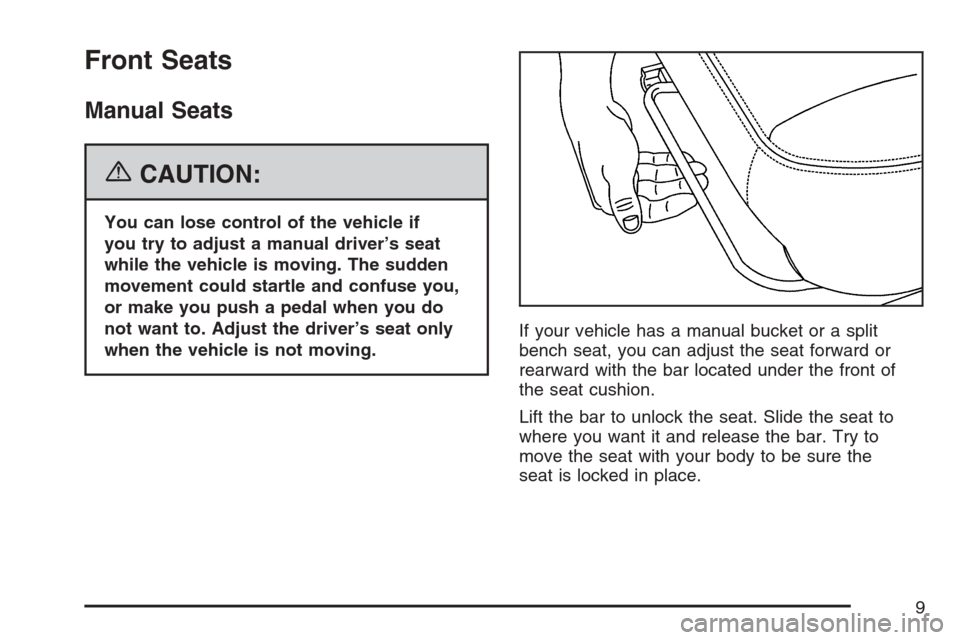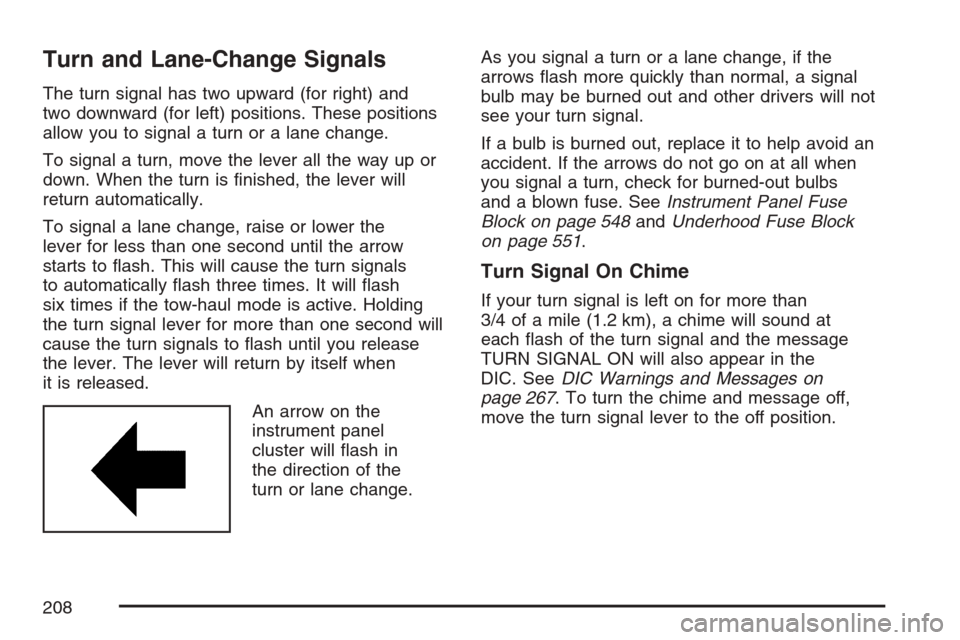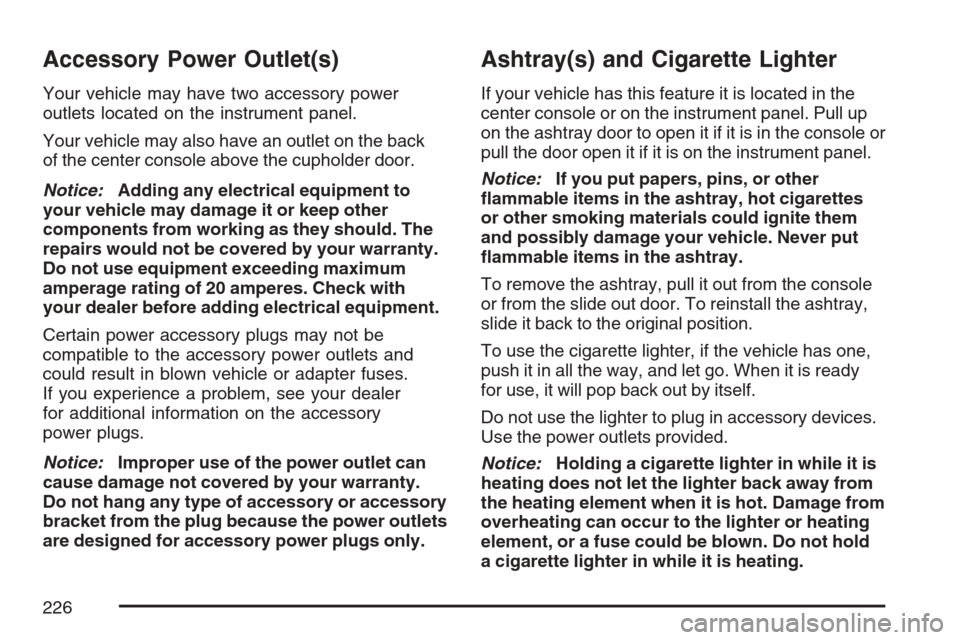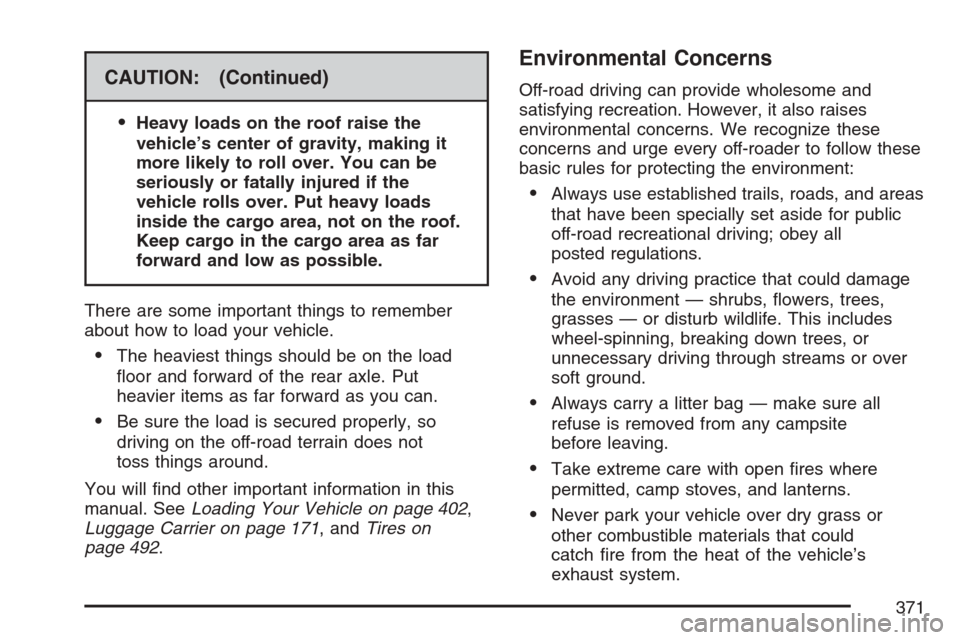2007 CHEVROLET AVALANCHE fuse
[x] Cancel search: fusePage 9 of 618

Front Seats
Manual Seats
{CAUTION:
You can lose control of the vehicle if
you try to adjust a manual driver’s seat
while the vehicle is moving. The sudden
movement could startle and confuse you,
or make you push a pedal when you do
not want to. Adjust the driver’s seat only
when the vehicle is not moving.If your vehicle has a manual bucket or a split
bench seat, you can adjust the seat forward or
rearward with the bar located under the front of
the seat cushion.
Lift the bar to unlock the seat. Slide the seat to
where you want it and release the bar. Try to
move the seat with your body to be sure the
seat is locked in place.
9
Page 14 of 618

If something has blocked the driver’s seat and/or
the adjustable pedals while recalling a memory
position, the driver’s seat and/or the adjustable
pedals recall may stop working. If this happens,
remove the obstruction and press the appropriate
control for the area that is not responding for
two seconds. Try recalling the memory position
again by pressing the appropriate memory button.
If the memory position is still not recalling, see
your dealer for service.
Easy Exit Seat
The control for this feature is located on the
driver’s door panel between buttons 1 and 2.
With the vehicle in PARK (P), the driver’s seat exit
position can be recalled by pressing the exit
button. You will hear a single beep, and the
driver’s seat will move back.
If the easy exit seat feature is programmed in the
Driver Information Center (DIC), automatic
seat movement will occur when the key is removed
from the ignition. See “EASY EXIT SEAT” under
DIC Vehicle Customization (With DIC Buttons)
on page 278for more information.The memory seat and easy exit features can also
be programmed using the DIC.
For programming information, seeDIC Vehicle
Customization (With DIC Buttons) on page 278.
Reclining Seatbacks
Manual Reclining Seatbacks
{CAUTION:
You can lose control of the vehicle if
you try to adjust a manual driver’s seat
while the vehicle is moving. The sudden
movement could startle and confuse you,
or make you push a pedal when you do
not want to. Adjust the driver’s seat only
when the vehicle is not moving.
14
Page 120 of 618

Testing the Alarm
The alarm can be tested by following these steps:
1. From inside the vehicle, lower the driver’s
window and open the driver’s door.
2. Activate the system by locking the doors with
the power door lock switch while the door is
open, or with the RKE transmitter.
3. Get out of the vehicle, close the door and wait
for the security light to go out.
4. Then reach in through the window, unlock the
door with the manual door lock and open the
door. This should set off the alarm.
While the alarm is set, the power door unlock
switch is not operational.
If the alarm does not sound when it should but the
headlamps �ash, check to see if the horn works.
The horn fuse may be blown. To replace the fuse,
seeInstrument Panel Fuse Block on page 548
andUnderhood Fuse Block on page 551.
If the alarm does not sound or the headlamps
do not �ash, the vehicle should be serviced
by your dealer.
PASS-Key®III+
The PASS-Key®III+ system operates on a radio
frequency subject to Federal Communications
Commission (FCC) Rules and with Industry
Canada.
This device complies with Part 15 of the
FCC Rules. Operation is subject to the
following two conditions:
1. This device may not cause harmful
interference.
2. This device must accept any interference
received, including interference that may
cause undesired operation.
This device complies with RSS-210 of Industry
Canada. Operation is subject to the following
two conditions:
1. This device may not cause interference.
2. This device must accept any interference
received, including interference that may
cause undesired operation of the device.
Changes or modi�cations to this system by
other than an authorized service facility could
void authorization to use this equipment.
120
Page 121 of 618

PASS-Key®III+ uses a radio frequency
transponder in the key that matches a decoder
in your vehicle.
PASS-Key®III+ Operation
Your vehicle has PASS-Key®III+ (Personalized
Automotive Security System) theft-deterrent
system. PASS-Key
®III+ is a passive theft-deterrent
system. This means you do not have to do anything
special to arm or disarm the system. It works when
you transition the key to RUN, ACCESSORY or
START from the OFF position.
When the PASS-Key
®III+ system senses that
someone is using the wrong key, it prevents
the vehicle from starting. Anyone using a
trial-and-error method to start the vehicle will be
discouraged because of the high number of
electrical key codes.
If the engine does not start and the security light on
the instrument panel cluster comes on when trying
to start the vehicle, the key may have a damaged
transponder. Turn the ignition off and try again.If the engine still does not start, and the key
appears to be undamaged, try another ignition
key. At this time, you may also want to check
the fuse, seeFuses and Circuit Breakers on
page 548. If the engine still does not start with
the other key, your vehicle needs service.
If your vehicle does start, the �rst key may be
faulty. See your dealer who can service the
PASS-Key
®III+ to have a new key made.
In an emergency, contact Roadside Assistance.
It is possible for the PASS-Key
®III+ decoder
to learn the transponder value of a new or
replacement key. Up to nine additional keys may
be programmed for the vehicle. The following
procedure is for programming additional keys only.
If all the currently programmed keys are lost or
do not operate, you must see your dealer or
a locksmith who can service PASS-Key
®III+ to
have keys made and programmed to the system.
See your dealer or a locksmith who can service
PASS-Key
®III+ to get a new key blank that is cut
exactly as the ignition key that operates the system.
121
Page 208 of 618

Turn and Lane-Change Signals
The turn signal has two upward (for right) and
two downward (for left) positions. These positions
allow you to signal a turn or a lane change.
To signal a turn, move the lever all the way up or
down. When the turn is �nished, the lever will
return automatically.
To signal a lane change, raise or lower the
lever for less than one second until the arrow
starts to �ash. This will cause the turn signals
to automatically �ash three times. It will �ash
six times if the tow-haul mode is active. Holding
the turn signal lever for more than one second will
cause the turn signals to �ash until you release
the lever. The lever will return by itself when
it is released.
An arrow on the
instrument panel
cluster will �ash in
the direction of the
turn or lane change.As you signal a turn or a lane change, if the
arrows �ash more quickly than normal, a signal
bulb may be burned out and other drivers will not
see your turn signal.
If a bulb is burned out, replace it to help avoid an
accident. If the arrows do not go on at all when
you signal a turn, check for burned-out bulbs
and a blown fuse. SeeInstrument Panel Fuse
Block on page 548andUnderhood Fuse Block
on page 551.
Turn Signal On Chime
If your turn signal is left on for more than
3/4 of a mile (1.2 km), a chime will sound at
each �ash of the turn signal and the message
TURN SIGNAL ON will also appear in the
DIC. SeeDIC Warnings and Messages on
page 267. To turn the chime and message off,
move the turn signal lever to the off position.
208
Page 226 of 618

Accessory Power Outlet(s)
Your vehicle may have two accessory power
outlets located on the instrument panel.
Your vehicle may also have an outlet on the back
of the center console above the cupholder door.
Notice:Adding any electrical equipment to
your vehicle may damage it or keep other
components from working as they should. The
repairs would not be covered by your warranty.
Do not use equipment exceeding maximum
amperage rating of 20 amperes. Check with
your dealer before adding electrical equipment.
Certain power accessory plugs may not be
compatible to the accessory power outlets and
could result in blown vehicle or adapter fuses.
If you experience a problem, see your dealer
for additional information on the accessory
power plugs.
Notice:Improper use of the power outlet can
cause damage not covered by your warranty.
Do not hang any type of accessory or accessory
bracket from the plug because the power outlets
are designed for accessory power plugs only.
Ashtray(s) and Cigarette Lighter
If your vehicle has this feature it is located in the
center console or on the instrument panel. Pull up
on the ashtray door to open it if it is in the console or
pull the door open it if it is on the instrument panel.
Notice:If you put papers, pins, or other
�ammable items in the ashtray, hot cigarettes
or other smoking materials could ignite them
and possibly damage your vehicle. Never put
�ammable items in the ashtray.
To remove the ashtray, pull it out from the console
or from the slide out door. To reinstall the ashtray,
slide it back to the original position.
To use the cigarette lighter, if the vehicle has one,
push it in all the way, and let go. When it is ready
for use, it will pop back out by itself.
Do not use the lighter to plug in accessory devices.
Use the power outlets provided.
Notice:Holding a cigarette lighter in while it is
heating does not let the lighter back away from
the heating element when it is hot. Damage from
overheating can occur to the lighter or heating
element, or a fuse could be blown. Do not hold
a cigarette lighter in while it is heating.
226
Page 371 of 618

CAUTION: (Continued)
Heavy loads on the roof raise the
vehicle’s center of gravity, making it
more likely to roll over. You can be
seriously or fatally injured if the
vehicle rolls over. Put heavy loads
inside the cargo area, not on the roof.
Keep cargo in the cargo area as far
forward and low as possible.
There are some important things to remember
about how to load your vehicle.
The heaviest things should be on the load
�oor and forward of the rear axle. Put
heavier items as far forward as you can.
Be sure the load is secured properly, so
driving on the off-road terrain does not
toss things around.
You will �nd other important information in this
manual. SeeLoading Your Vehicle on page 402,
Luggage Carrier on page 171, andTires on
page 492.
Environmental Concerns
Off-road driving can provide wholesome and
satisfying recreation. However, it also raises
environmental concerns. We recognize these
concerns and urge every off-roader to follow these
basic rules for protecting the environment:
Always use established trails, roads, and areas
that have been specially set aside for public
off-road recreational driving; obey all
posted regulations.
Avoid any driving practice that could damage
the environment — shrubs, �owers, trees,
grasses — or disturb wildlife. This includes
wheel-spinning, breaking down trees, or
unnecessary driving through streams or over
soft ground.
Always carry a litter bag — make sure all
refuse is removed from any campsite
before leaving.
Take extreme care with open �res where
permitted, camp stoves, and lanterns.
Never park your vehicle over dry grass or
other combustible materials that could
catch �re from the heat of the vehicle’s
exhaust system.
371
Page 427 of 618

Trailer Wiring Harness
Heavy-Duty Trailer Wiring Package
Your vehicle is equipped with the seven-wire
trailer towing harness. This harness with a
seven-pin universal heavy-duty trailer connector
is attached to the rear bumper beam. It is located
next to the integrated trailer hitch.The seven-wire harness contains the following
trailer circuits:
Yellow: Left Stop/Turn Signal
Dark Green: Right Stop/Turn Signal
Brown: Taillamps
White: Ground
Light Green: Back-up Lamps
Red: Battery Feed **#
Dark Blue: Trailer Brake #
** If you are charging a remote (non-vehicle)
battery, press the tow/haul mode button located
at the end of the shift lever. This will boost
the vehicle system voltage and properly charge
the battery. If the trailer is too light for tow/haul
mode, you can turn on the headlamps as a
second way to boost the vehicle system and
charge the battery.
# The fuses for these circuits are installed in the
underhood electrical center, but the wires are
not connected. These circuits should be connected
by your dealer or a quali�ed service technician.
427